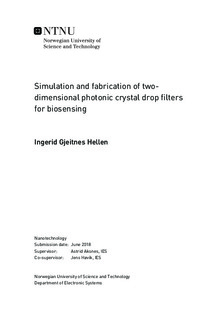Simulation and fabrication of two-dimensional photonic crystal drop filters for biosensing
Master thesis
Permanent lenke
http://hdl.handle.net/11250/2564177Utgivelsesdato
2018Metadata
Vis full innførselSamlinger
Sammendrag
The main goal of this master thesis was to design and fabricate a biosensor consisting of a 2D photonic crystal. Its periodicity was made by etching a hexagonal hole pattern in a silicon slab, and a few linear defects were added by removing some of the holes. The result was a drop filter consisting of two waveguides with a resonator between them, all of which were positioned on top of a layer of silicon oxide. The idea was that light would couple, or "drop", from one waveguide to the other if, and only if, it belonged to a resonance frequency, hence the name of the filter. However, the exact resonance frequencies would depend upon the refractive index of the surrounding media, making the filter able to sense its surroundings.
To reach that goal, several issues had to be addressed regarding the fabrication method, including silicon growth and etch times, increases in the hole radius relative to the exposure mask and resist cracking. In addition, an estimate of the refractive index n=3.37 for the amorphous silicon slab was found using a combination of simulations and fabrications.
Simulation tools were also used both to optimize the silicon slab thickness, which was the only major parameter that had not been optimized during the project thesis, and to measure the biosensing abilities of the device. In addition, they were used to test the possibility of combining two drop filters along one waveguide, called multiplexing.
The results from the work mentioned above were used to fabricate a set of functioning drop filters. They resonated nicely, creating a high-intensity peak on the transmission graphs for the dropped light. Finally, the biosensing abilities of the drop filters were tested by changing the surrounding medium from air to purified water both inside the photonic crystal holes and above the crystal. It resulted in a resonance shift of approximately 25nm, which corresponded to a normalized frequency shift of 0.0043. The goal of the project can therefore be considered as reached.
